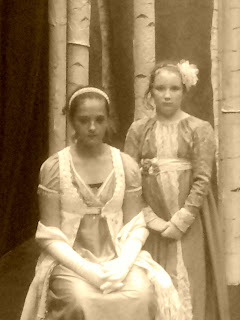Jakob and Wilhelm Grimm gathered their original collection of tales primarily between 1807 and 1812. They continued adding to the collection and publishing them in various editions between 1812 and 1857. In their manuscripts, the Brothers Grimm acknowledged the geographic regions in which the stories were recounted to them but rarely the individual tellers. By omission and suggestion, they perpetuated the image of them transcribing the tales directly from the mouths of aged peasants in the countryside. Recent scholarship has established that most of the early tales they collected were actually told to them by middle and upper class young women, ranging in age from as young as seven to as old as their early twenties, who recounted the stories told to them by their nursemaids and servants.
Why did their female contributors allow their stories to be used without due credit? Perhaps it was because women of the time so accustomed to doing everything they did without acknowledgment from men. Jakob Grimm probably would have claimed that a collection of stories known to be told by young women would never have achieved publication or popular acceptance and it was vital for the stories to give his people a national German identity to counteract their domination under the French Emperor Napoleon. While the Romantic writers idealized the wisdom of the common-folk, they did not grant the same respect to the women of their same social standing.
In creating this play, I imagined what might have happened had the female contributors had resisted the theft of their stories and had asserted their claim for due recognition. Would they have been rebuffed by the Grimm brothers, or would they have voluntarily sublimated their contributions to the project so that other women, silenced as they had been, could find their own voices from their stories?
Lest I be accused of committing the same oversight as the Brothers Grimmm, I must acknowledge my indebtedness to Valerie Paradiz for her compelling book Clever Maids. While, like Jakob and Wilhelm, I am beholden to the work of male scholars such as Jack Zipes for the documentation of the stories, Paradiz’s compelling narrative has breathed life into the forgotten tales of the female contributors. While their names were forgotten until recent decades, these “clever maids” infused the female characters of the well-known and lesser-known Grimm tales with strength, cunning, and silent protest.
I have taken some liberty with the ages of the characters. The golden age of the Grimm’s gathering stretched over several years, from 1807 to 1815, and the brothers’ interest in folklore stretched back to their teenage years as prodigious scholars. I have tended to paint the female characters as a little younger than they would have been in 1810, though they would have been closer to the ages as they appear in the play when they first began to contribute their stories.
I’ve felt justified in stretching the ages for two reasons. First, it makes a better story, and Wilhelm particularly appreciated the need to modify the original tales to make the stories stronger. Second, the Grimm siblings played roles that were both older and younger than their chronological age would have normally demanded. Jakob, Wilhelm, and Lottie had to assume adult responsibilities in the caretaking of their family as teenagers while younger brothers Ferdinand, Karl, and Ludwig, benefitting from their elder brothers’ diligence, acted like dependent boys well into their twenties. While I may have stretched the chronology, I’ve remained true to the challenges inherent in the childhood and adolescence of these characters. Although the characters may not have been quite as young in 1810 as they are portrayed in the script, the Grimm tales were collected and told by young zealots rather than aged cynics. These are stories told and collected by young people that continue to resonate with today’s youth.




